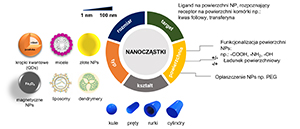Nanoparticles in chemotherapy: characteristics, design strategies, mechanism of internalization and intracellular degradation
DOI:
https://doi.org/10.18388/pb.2021_441Abstract
Although significant advances have been made in cancer treatment, effective methods of treatment are still limited. Classical chemotherapy is one of the main cancer treatments, but it often causes many side effects that may cause non-specific drug action. This is mainly due to the lack of significant differences between cancer and normal cells as well as drug resistance. To reduce the side effects and increase the specificity and the selectivity of chemotherapeutics to cancer cells, new methods of their delivery to tumors are being sought. One of these methods is the application of nanoparticles (NPs), e.g. Quantum Dots (QDs) as drug delivery platforms. This review describes the most popular NPs in chemotherapy, including quantum dots, gold nanoparticles, dendrimers, micelles, and liposomes. The review describes also a strategy of design and synthesis of NPs, mechanism of cellular uptake, as well as intracellular degradation and toxicity of NPs.

Published
Issue
Section
License
Copyright (c) 2022 Joanna Pilch

This work is licensed under a Creative Commons Attribution 4.0 International License.
All journal contents are distributed under the Creative Commons Attribution-ShareAlike 4.0 International (CC BY-SA 4.0) license. Everybody may use the content following terms: Attribution — You must give appropriate credit, provide a link to the license, and indicate if changes were made, ShareAlike — If you remix, transform, or build upon the material, you must distribute your contributions under the same license as the original. There are no additional restrictions — You may not apply legal terms or technological measures that legally restrict others from doing anything the license permits.
Copyright for all published papers © stays with the authors.
Copyright for the journal: © Polish Biochemical Society.



